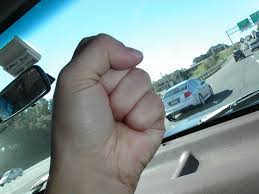6 Common Road Rage Crimes
If you spend enough time driving on California’s roads, it is bound to happen: another driver at some point is going to do something that will make you angry. It could be the man who cuts you off while he is failing miserably at eating his lunch while driving. It could be the woman who sits jabbering away on her phone, completely unaware that the light has been green for the past 10 seconds.

For Deirdre Orozco, the breaking point was when Delanie Strykul and Vanessa Gladieux allegedly flipped her the bird after Orozco reportedly cut in front of them on Interstate 80 in Northern California. 1 Orozco, 50, allegedly then forced their car off the road, walked over to the car, flashed a badge of some sort and claimed she was a sheriff’s deputy. The two terrified women called the California Highway Patrol, who arrested Orozco on suspicion of reckless driving, assault with a deadly weapon (her vehicle), false imprisonment, unlawful use of a badge and resisting arrest. Strykul and Gladieux captured the incident on video using a cellphone camera.
It is called “road rage,” a clever catchall phrase that is used to describe a set of violent or aggressive behaviors that you might commit after one too many drivers do something that you did not like. Although there is no actual “road rage” law in California, road rage cases often involve one or more of the following crimes.
1. Assault with a Deadly Weapon (California Penal Code Section 245(a)(1))
Like Orozco is alleged to have done, if you use a car as a weapon, you could be charged with assault with a deadly weapon. Assault with a deadly weapon requires that a person commit an assault upon the person of another through the use of an instrument (in this case, a car) with enough force that it is likely to produce great bodily injury.
The crime is a “wobbler,” which means it can be punished as either a misdemeanor or a felony in California. Felony assault with a deadly weapon carries a maximum sentence of four years in county jail and/or a fine of up to $10,000. A misdemeanor conviction for assault with a deadly weapon is punishable by 364 days in jail and a fine of up to $10,000.
Assault with ad deadly weapon could also count as a strike under California’s Three Strikes Law if:
- You inflicted great bodily injury on the victim
- You used a firearm in the commission of the crime, or
- You committed the assault against a peace officer
2. Assault (California Penal Code Section 240)
Under California law, assault (sometimes referred to as “simple” assault) is defined as the unlawful attempt, coupled with a present ability, to commit a violent injury on the person of another. Physical contact does not actually need to be made with the other person for this crime.
In a road rage example, suppose that after an accident with another driver, you pick up some stones and throw them at the other driver’s head, but you miss. You could still be convicted of assault because you willfully committed an act that would have resulted in force being applied to the other person, you knew that the result of your action was a likely application of force to the other person, and you had the ability to apply that force to the other person.
Assault is a misdemeanor, and can be punished by up to six months in county jail and fines of up to $1,000.
3. Battery (California Penal Code Section 242)

California’s battery law consists of just one sentence: a battery is any willful and unlawful use of force or violence upon the person of another.
In order to be convicted of battery under PC 242, the prosecution must show that you intended to commit the act or touching. However, the prosecution is not required to show that you intended to injure the other person with your act.
Battery is punishable by imprisonment in a county jail for up to six months and a maximum fine of $2,000. However, if the victim sustains a serious bodily injury, the sentence can be increased to a maximum of four years in county jail.
4. Hit and Run (California Vehicle Code Sections 20001 and 20002)
Hit-and-run occurs when a driver leaves the scene of an accident without exchanging information with the other driver. In California, the law that is applied depends on the outcome of the accident. If the victim is killed, or suffers a serious and permanent injury, Vehicle Code Section 20001 applies. If the accident only resulted in property damage, the driver can be charged under Vehicle Code Section 20002.
Hit-and-run resulting in injury or death is a wobbler. If the hit-and-run victim receives a serious, permanent injury, or if the victim dies, a conviction can result in a sentence ranging between 90 days in county jail and four years in state prison. Fines can range between $1,000 and $10,000.
Hit-and-run resulting in property damage is a misdemeanor, and can be punished by up to six months in county jail and a $1,000 fine.
5. Reckless Driving (California Vehicle Code Sections 23103 and 23104)
Any driver who willfully or wantonly drives with a disregard for the safety of persons or property is guilty of reckless driving. Examples of this type of driving include excessive speeding, tailgating, or intentionally swerving to block a driver from passing.
If you recklessly drive and cause no injuries, you can be convicted of a misdemeanor and sentenced to serve up to 90 days in county jail, and fined between $145 and $1,000. If your actions cause an injury, the sentence can be increased by up to six months in jail. The penalty for reckless driving can also be increased if you have previous convictions for reckless driving or driving under the influence.
6. Criminal Threats (California Penal Code Section 422)
You might also be charged with making a criminal threat during a road rage incident. It is a crime under California law to make any communication – whether spoken, written, or transmitted through electronic means (such as a text message or email) – that places another person in a state of reasonable sustained fear for his or her safety, or for the safety of his or her immediate family. This applies to a threat that you make without the intention of ever following through with the threat. A sustained fear is one that lasts more than just a brief moment, but can be as short as 30 seconds.
For example, suppose you and another driver collided and you have pulled off to the side of the freeway. Angrily, you pop your trunk, get out of your car, and pull out a tire iron. You start walking toward the other driver, pointing the tire iron at him, and you shout, “I’m going to beat you to death!” The other person, seeing that you are angry, and seeing that you are holding a weapon, would have a reasonable and sustained fear that you were going to carry out your threat.
If you are convicted of making a criminal threat, you can face up to 364 days in county jail on a misdemeanor conviction, and up to four years in state prison on a felony conviction. Additionally, use of a deadly weapon could increase your sentence by another year. A felony also counts as a strike against you under California’s Three Strikes Law.
Contact Wallin & Klarich Today If You are Facing Criminal Charges

If you or someone you know has been arrested for crimes stemming from a road rage incident, you should speak to an experienced criminal defense attorney at Wallin & Klarich today. Using an effective defense strategy specifically tailored to the facts of your case, we may be able to get the charges against you reduced or dismissed altogether. We can help you minimize the consequences and help you obtain the best possible result in your case.
Our attorneys at Wallin & Klarich have over 40 years of experience successfully fighting for the rights of our clients. With offices in Los Angeles, Sherman Oaks, Torrance, Tustin, San Diego, Riverside, San Bernardino, Ventura, West Covina and Victorville, Wallin & Klarich has been successful in defending thousands of clients charged with serious criminal offenses.
Call us today at (877) 4-NO-JAIL or (877) 466-5245 for a free telephone consultation. We will get through this together.
1. [Steven Hoffer, “Woman Allegedly Posed As Sheriff, Rammed Other Car in Road Rage,” Huffington Post, December 26, 2014, available at http://www.huffingtonpost.com/2014/12/26/deirdre-orozco-road-rage_n_6382738.html.]↩


